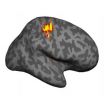(Press-News.org) Researchers at Karolinska Institutet in Sweden have found an explanation for why the level of kynurenic acid (KYNA) is higher in the brains of people with schizophrenia or bipolar disease with psychosis. The study, which is published in the scientific periodical Molecular Psychiatry, identifies a gene variant associated with an increased production of KYNA. The discovery contributes to the further understanding of the link between inflammation and psychosis – and might pave the way for improved therapies.
Kynurenic acid (KYNA) is a substance that affects several signalling pathways in the brain and that is integral to cognitive function. Earlier studies of cerebrospinal fluid have shown that levels of KYNA are elevated in the brains of patients with schizophrenia or bipolar diseases with psychotic features. The reason for this has, however, not been fully understood.
KMO is an enzyme involved in the production of KYNA, and the Karolinska Institutet team has now shown that some individuals have a particular genetic variant of KMO that affects its quantity, resulting in higher levels of KYNA. The study also shows that patients with bipolar disease who carry this gene variant had almost twice the chance of developing psychotic episodes.
KYNA is produced in inflammation, such as when the body is exposed to stress and infection. It is also known that stress and infection may trigger psychotic episodes. The present study provides a likely description of this process, which is more likely to occur in those individuals with the gene variant related to higher production of KYNA. The researchers also believe that the discovery can help explain certain features of schizophrenia or development of other psychotic conditions.
"Psychosis related to bipolar disease has a very high degree of heredity, up to 80 per cent, but we don't know which genes and which mechanisms are involved," says Martin Schalling, Professor of medical genetics at Karolinska Institutet's Department of Molecular Medicine and Surgery, also affiliated to the Center for Molecular Medicine (CMM). "This is where our study comes in, with a new explanation that can be linked to signal systems activated by inflammation. This has consequences for diagnostics, and paves the way for new therapies, since there is a large arsenal of already approved drugs that modulate inflammation."
###
The study was financed with grants from Karolinska Institutet, the Swedish Research Council, the Söderström-Königska Foundation, the Royal Physiographic Society, the Fredrik and Ingrid Thuring Foundation, the Åhlén Foundation, the Department of Clinical Psychiatry at Huddinge University Hospital, the William Lion Penzner Foundation and the US government.
Publication: 'The KMO allele encoding Arg452 is associated with psychotic features in bipolar disorder type 1, and with increased CSF KYNA level and KMO expression', Catharina Lavebratt, Sara Olsson, Lena Backlund, Louise Frisén, Carl Sellgren, Lutz Priebe, Pernilla Nikamo, Lil Träskman-Bendz, Sven Cichon, Marquis P. Vawter, Urban Ösby, Göran Engberg, Mikael Landén, Sophie Erhardt, and Martin Schalling, Molecular Psychiatry, online first 5 March 2013. Embargoed until Tuesday 5 March at 9 am UK time / 10 am CET / 4 am US ET.
For further information about the study, please contact:
Dr. Catharina Lavebratt, Associate Professor
Department of Molecular Medicine and Surgery, Karolinska Institutet
Tel: 46-08-5177 6524.
Email: catharina.lavebratt@ki.se
Dr. Martin Schalling, Professor
Department of Molecular Medicine and Surgery, Karolinska Institutet
Tel: 46-070-4841230
Email: martin.schalling@ki.se
Contact the Press Office: ki.se/pressroom
Karolinska Institutet – a medical university: ki.se/English END
New gene variant may explain psychotic features in bipolar disorder
2013-03-05
ELSE PRESS RELEASES FROM THIS DATE:
Discovery of human genetic mutation could lead to new treatments for type 1 diabetes
2013-03-05
In type 1 diabetes, the immune system destroys insulin-producing cells in the pancreas, but the precise cause has not been clear. A study published by Cell Press on March 5th in Cell Metabolism reveals that a single mutation in the "longevity gene" SIRT1 can cause type 1 diabetes in humans. The findings unearth the role this gene plays in human autoimmunity and disease and also offer new avenues for treating a range of autoimmune disorders.
"We describe one of the first single gene defects leading to type 1 diabetes, as well as the first human mutation in the SIRT1 gene," ...
Molecular coordination in evolution: A review in 'Nature Reviews Genetics'
2013-03-05
Spanish National Cancer Research Centre (CNIO) researchers Alfonso Valencia, Director of the Structural Biology and Biocomputing Programme and David de Juan, jointly with Florencio Pazos, from the Spanish National Centre for Biotechnology (CNB-CSIC), publish a review on the latest computational methods that, based on evolutionary principles, are revolutionising the field of analysis and prediction of protein structure, function and protein-protein interactions, as well as the short- and long-term expectations for the field.
"The computational and mathematical analysis ...
How cells optimize the functioning of their power plants
2013-03-05
Mitochondria, which are probably derived from distant bacterial ancestors incorporated into our cells, have their own DNA. However, we know little about how these organelles, which convert oxygen and consumed nutrients into energy, regulate the expression of their own genes. Jean-Claude Martinou, professor at the University of Geneva (UNIGE), Switzerland, and his team, have discovered the existence of compartments at the heart of mitochondria, consisting of hundreds of different proteins. It is here that RNA molecules (the many copies made from DNA) come together to be ...
Single gene might explain dramatic differences among people with schizophrenia
2013-03-05
March 5, 2013 (Toronto) – Some of the dramatic differences seen among patients with schizophrenia may be explained by a single gene that regulates a group of other schizophrenia risk genes. These findings appear in a new imaging-genetics study from the Centre for Addiction and Mental Health (CAMH).
The study revealed that people with schizophrenia who had a particular version of the microRNA-137 gene (or MIR137), tended to develop the illness at a younger age and had distinct brain features – both associated with poorer outcomes – compared to patients who did not have ...
Viruses: More survival tricks than previously thought
2013-03-05
Among eukaryotes with modified nuclear genetic codes, viruses are unknown. Until now it had been believed that the modifications to the genetic code effectively prevented new viral infections. However, researchers have now reported the first example of a virus that can be shown to have crossed the boundary from organisms using the standard genetic code to those with an alternate genetic code.
"The finding is significant because it means that virus-host co-evolution after a genetic code shift can be more extensive than previously thought", said researcher Derek J. Taylor, ...
West Nile virus passes from female to eggs, but less so from larvae to adults
2013-03-05
In California Culex mosquitoes are considered to be the principle vectors of West Nile virus (WNV), which infects birds, humans, and other mammals during the summer. In addition, these mosquitoes may also serve as overwintering reservoir hosts as the virus is passed "vertically" from female mosquito to egg, then larva, and then adult.
To find out how often this happens, California researchers monitored WNV in mosquitoes in the field and in the lab, and observed how the virus is transmitted between generations and between insect stages. The results are published in the ...
Remains of extinct giant camel discovered in High Arctic by Canadian Museum of Nature
2013-03-05
Ottawa, Canada, March 5, 2013 - A research team led by the Canadian Museum of Nature has identified the first evidence for an extinct giant camel in Canada's High Arctic. The discovery is based on 30 fossil fragments of a leg bone found on Ellesmere Island, Nunavut and represents the most northerly record for early camels, whose ancestors are known to have originated in North America some 45 million years ago.
The fossils were collected over three summer field seasons (2006, 2008 and 2010) and are about three-and-a-half million years old, dating from the mid-Pliocene ...
Amputee phantom pain linked to brain retaining picture of missing limb
2013-03-05
Changes in the brain following amputation have been linked to pain arising from the missing limb, called 'phantom pain', in an Oxford University brain imaging study.
Arm amputees experiencing the most phantom limb pain were found to maintain stronger representation of the missing hand in the brain – to the point where it was indistinguishable from people with both hands.
The researchers hope their identification of brain responses correlated with the level of phantom pain can aid the development of treatment approaches, as well as increase understanding of how the brain ...
Ancient DNA solves 320-year-old mystery
2013-03-05
University of Adelaide researchers have found the answer to one of natural history's most intriguing puzzles – the origins of the now extinct Falkland Islands wolf and how it came to be the only land-based mammal on the isolated islands – 460km from the nearest land, Argentina.
Previous theories have suggested the wolf somehow rafted on ice or vegetation, crossed via a now-submerged land bridge or was even semi-domesticated and transported by early South American humans.
The 320-year-old mystery was first recorded by early British explorers in 1690 and raised again ...
Mental picture of others can be seen using fMRI, finds new study
2013-03-05
ITHACA, N.Y. – It is possible to tell who a person is thinking about by analyzing images of his or her brain. Our mental models of people produce unique patterns of brain activation, which can be detected using advanced imaging techniques according to a study by Cornell University neuroscientist Nathan Spreng and his colleagues.
"When we looked at our data, we were shocked that we could successfully decode who our participants were thinking about based on their brain activity," said Spreng, assistant professor of human development in Cornell's College of Human Ecology.
Understanding ...



